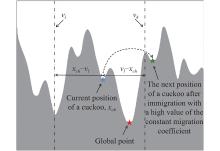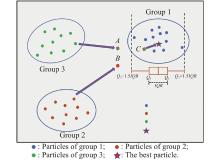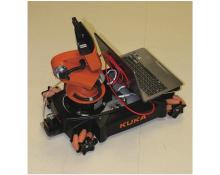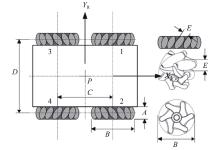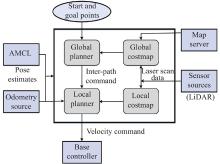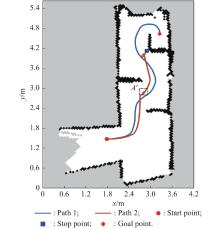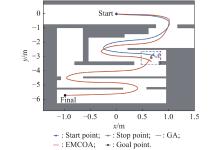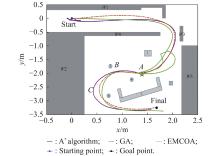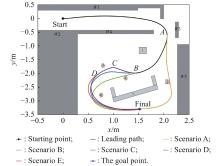| 1 |
LAVALLE S M. Planning algorithms. Cambridge: Cambridge University Press, 2006.
|
| 2 |
QU H, YANG X S, WILLMS A R, et al Real-time robot path planning based on a modified pulse-coupled neural network model. IEEE Trans. On Neural Networks, 2009, 20 (11): 1724- 1739.
doi: 10.1109/TNN.2009.2029858
|
| 3 |
YUN S C, PARASURAMAN S, GANAPATHY V. Dynamic path planning algorithm in mobile robot navigation. Proc. of the IEEE Symposium on Industrial Electronics and Applications, 2011: 364–369.
|
| 4 |
YAZDANI H, FALLAH A, HOSEINI S M A new approach for robot path planning with genetic algorithms. Journal of Basic and Applied Scientific Research, 2012, 4, 4122- 4129.
|
| 5 |
TAXIR M L, AZOUAUI O, HAZERCHI M, et al Mobile robot path planning for complex dynamic environments. Proc. of the International Conference on Advanced Robotics, 2015, 200- 206.
|
| 6 |
DE CARVALJO SANTOS V, FABIANO MOTTA TOLEDO C, SANTOS OSORIO F An exploratory path planning method based on genetic algorithm for autonomous mobile robots. Proc. of the 2015 IEEE Congress on Evolutionary Computation, 2015, 62- 69.
|
| 7 |
GARRIDO S, BLANCO D, MORENO L. SLAM and exploration using differential evolution and fast marching. InTechOpen, 2011.
|
| 8 |
YU C Q, WANG Z R. UAV path planning using gso-de algorithm. Proc. of the 2013 IEEE International Conference of IEEE Region, 2013: 1–4.
|
| 9 |
MO H W, MENG L L Robot path planning based on differential evolution in static environment. International Journal of Digital Content Technology and its Applications, 2012, 6 (20): 122- 129.
doi: 10.4156/jdcta.vol6.issue20.14
|
| 10 |
JATI A, SINGH G, RAKSHIT P, et al. A hybridisation of improved harmony search and bacterial foraging for multi-robot motion planning. Proc. of the IEEE Congress on Evolutionary Computation, 2012: 1–8.
|
| 11 |
PANOV S, KOCESKI S. Harmony search-based algorithm for mobile robot global path planning. Proc. of the 2nd Mediterranean Conference on Embedded Computing, 2013: 168–171.
|
| 12 |
DRAKE D, KOZIOL S, CHABOT E Mobile robot path planning with a moving goal. IEEE Access, 2018, 6, 12800- 12814.
doi: 10.1109/ACCESS.2018.2797070
|
| 13 |
FARIDI A Q, SHARMA S, SHUKLA A, et al Multi-robot multi-target dynamic path planning using artificial bee colony and evolutionary programming in unknown environment. Intelligent Service Robotics, 2018, 11 (2): 171- 186.
doi: 10.1007/s11370-017-0244-7
|
| 14 |
JIANG L, HUANG H Y, DING Z H Path planning for intelligent robots based on deep q-learning with experience replay and heuristic knowledge. IEEE/CAA Journal of Automatica Sinica, 2019, 7 (4): 1179- 1189.
|
| 15 |
LAMINI C, BENHLIMA S, ELBEKRI A Genetic algorithm-based approach for autonomous mobile robot path planning. Procedia Computer Science, 2018, 127, 180- 189.
doi: 10.1016/j.procs.2018.01.113
|
| 16 |
PARQUE V, MIYASHITA T Smooth curve fitting of mobile robot trajectories using differential evolution. IEEE Access, 2020, 8, 82855- 82866.
doi: 10.1109/ACCESS.2020.2991003
|
| 17 |
LI F L, FAN X J, HOU Z X A firefly algorithm with self-adaptive population size for global path planning of mobile robot. IEEE Access, 2020, 8, 168951- 168964.
doi: 10.1109/ACCESS.2020.3023999
|
| 18 |
YU X, CHEN W N, GU T L, et al ACO-A*: ant colony optimization plus A* for 3-D traveling in environments with dense obstacles. IEEE Trans on Evolutionary Computation, 2019, 23 (4): 617- 631.
doi: 10.1109/TEVC.2018.2878221
|
| 19 |
LI Z Y, LIU W D, GAO L E, et al Path planning method for AUV docking based on adaptive quantum-behaved particle swarm optimization. IEEE Access, 2019, 78665- 78674.
|
| 20 |
ZHANG J H, ZHANG Y, ZHOU Y Path planning of mobile robot based on hybrid multi-objective bare bones particle swarm optimization with differential evolution. IEEE Access, 2018, 6, 44542- 44555.
doi: 10.1109/ACCESS.2018.2864188
|
| 21 |
JUAN C F, LIN C H, AND BUI T B Multi-objective rule-based cooperative continuous ant colony optimized fuzzy systems with a robot control application. IEEE Trans. on Cybernetics, 2018, 50 (2): 650- 663.
|
| 22 |
JUANG C F, LIN C H, BUI T B Multi-objective rule-based cooperative continuous ant colony optimized fuzzy systems with a robot control application. IEEE Trans. on Cybernetics, 2019, 115, 106- 120.
|
| 23 |
NAZARAHARI M, KHANMIRZA E, DOOSTIE S Multi-objective multi-robot path planning in continuous environment using an enhanced genetic algorithm. Expert Systems with Applications, 2019, 115, 106- 120.
doi: 10.1016/j.eswa.2018.08.008
|
| 24 |
YANG X S. Nature-inspired optimization algorithms. Waltham: Academic Press, 2020.
|
| 25 |
MOHSENI A, DUCHAIN V, WONG T. A comparative study of the optimal control design using evolutionary algorithms: application on a close-loop system. Proc. of the Intelligent Systems Conference, 2017: 942–948.
|
| 26 |
MOHSENI A, WONG T, DUCHAIN V MCOA: mutated and self-adaptive cuckoo optimization algorithm. Evolutionary Intelligence, 2016, 9 (1/2): 21- 36.
doi: 10.1007/s12065-016-0135-4
|
| 27 |
RAJABIOUN R Cuckoo optimization algorithm. Applied Soft Computing, 2011, 11 (8): 5508- 5518.
doi: 10.1016/j.asoc.2011.05.008
|
| 28 |
Youbot. Youbot detailed specifications –detailed base geometry. 2014. http://www.youbot-store.com/wiki/index.php/File:MeasurementData.png
|
| 29 |
DE GREEF F. Kuka youbot simulation. Amsterdam, Netherlands: University of Amsterdam, 2015.
|
 ), Vincent DUCHAINE(
), Vincent DUCHAINE( ), Tony WONG
), Tony WONG
